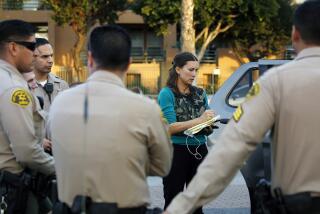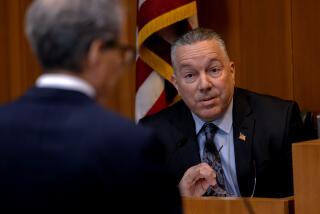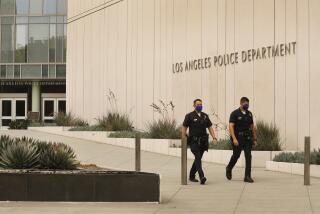Times Reporter Refuses to Tell Source, Is Fined
A Times reporter Thursday refused to disclose the confidential source of a Los Angeles Police Department Internal Affairs report on the Rodney G. King beating, prompting a judge to impose a $1,500 fine.
Superior Court Judge Bernard Kamins ordered the reporter, Richard A. Serrano, to appear every day in court until he reveals who leaked the 314-page report detailing the department’s investigation of the March 3 beating. Serrano wrote a May 21 article based on the report.
Kamins said he will fine Serrano $1,500 for each day he refuses to answer.
Attorney Robert Warren, representing the newspaper, told Kamins his action is clearly “an end run around the California shield law,” which protects journalists from revealing the identities of confidential sources. Warren said he would appeal the ruling “immediately.”
In a statement issued late Thursday, Shelby Coffey III, editor and executive vice president of The Times, called the judge’s decision “legally flawed.”
“The Los Angeles Times and Mr. Serrano will appeal this judicial excess,” Coffey said. “Judge Kamins’ action is a dangerous threat to a free press, and we expect that on appeal this attempt at coercion will be reversed.”
Kamins had ordered that neither the internal investigation nor personnel files on four Los Angeles officers indicted in the King case be made public. Serrano’s article detailing the internal investigation appeared one day after Kamins had reiterated his order.
At Thursday’s hearing, Kamins said he has asked the state attorney general’s office to investigate the document leak and said he wants to punish whoever provided it to The Times. He said he would continue to fine Serrano until he finds out.
“I intend to impose sanctions of $1,500, and issue an order tomorrow, the next day and the day after that” until the source is identified, Kamins said. “I just want to find out what happened and stop it.”
Kamins also said that if reporters continue to thwart his efforts to prevent the release of information that might jeopardize the officers’ trial, he may have to bring in jurors from another county. If that proves necessary, he said, he may seek to somehow hold the press financially responsible.
He insisted that he is in favor of press freedom, but wants to protect “the integrity of the court” and make sure future orders are not violated.
“My goals are different than your goals,” the judge told Warren. “In this matter, I cannot think of an alternative. . . . Should I do nothing about it and just sit here and smile?”
Serrano, standing behind the counsel table, acknowledged that he had obtained the documents on May 20, but repeatedly refused to answer further questions posed by the judge.
“I want to know if you received them from anyone who falls under my order,” Kamins told Serrano. “And if so, who was that person?”
“I refuse to answer that,” Serrano replied, citing both the First Amendment of the U.S. Constitution and the state’s shield law.
Kamins imposed the sanctions, but stayed them until June 10 at the request of attorneys for Serrano and The Times.
Kamins agreed that the shield law protects Serrano from a criminal contempt citation, but in a unique interpretation of case law, the judge held that the reporter is still subject to civil sanctions because he violated a court order and concealed criminal conduct by another person.
Warren said outside court that he would seek an immediate stay from the California 2nd District Court of Appeal and ask for emergency action to reverse the judge’s ruling.
He told reporters after the hearing that the judge is circumventing the protections afforded by the shield law by calling the punishment “sanctions” rather than “contempt.”
“The court has indicated that he believes that by proceeding under a civil statute which broadens the contempt powers, it isn’t called contempt so therefore the shield law doesn’t apply,” Warren said. “We believe that the effect is the same, namely a fine. It is contempt . . . a rose by any other name is still a rose.”
In his statement, Coffey called the judge’s action “a cardinal mistake.”
“His action is an attempt to end-run the constitutional protection for journalists in the shield law.
“Judge Kamins admits that Mr. Serrano is doing his job as a journalist. The judge admits the article will not prevent the choosing of an impartial jury from among the millions of residents in this area.
“The public is clearly best served by having this information available on this crucial case and it is not well served by a judge who himself created this controversy needlessly with an ill-conceived gag order and now is trying to bludgeon the press into enforcing it.”
The case is being closely watched as a test of the strengthened shield law.
Legal experts contacted by The Times said the judge’s action is a first in California and unlikely to be upheld by an appeals court.
“If precedent means anything, this will not hold up on appeal,” said Jonathan Kotler, associate professor of media law at the University of Southern California.
Kotler said Thursday’s decision is unique. “It’s not unique that a judge gets mad when he feels powerless,” Kotler said. “But this kind of action is unprecedented in California. He’s fashioning his own . . . remedy out of frustration.”
Nearly 20 years ago, Times reporter Bill Farr spent 46 days in jail after a judge held him in contempt for refusing to disclose the identity of people who had given him a sealed court document he used for a story on the Charles Manson gang that he wrote in a previous job at the Los Angeles Herald-Examiner.
In 1980, California voters reinforced the shield law by making it an amendment to the state Constitution. The law allows reporters to refuse to disclose the names of confidential informants as well as notes and other information obtained in the course of news gathering. Journalists argue that without legal protection, their sources would not provide information.
In a related action Thursday, Kamins vacated a contempt order against Assistant City Atty. David Hotchkiss, who had incurred the judge’s ire by making statements to reporters concerning the same material published in The Times.
The judge said Hotchkiss had “let the cat out of the bag” about the contents of the police Internal Affairs investigation, which had been ordered sealed, but concluded that it was a “slip of the tongue” by Hotchkiss. He fined the prosecutor $250.
The felony assault trial for the four officers is scheduled to begin June 19 with the start of jury selection. The defendants are Sgt. Stacey C. Koon and Officers Laurence M. Powell, Timothy E. Wind and Theodore J. Briseno.
APPEALED: Police Commission appeals judge’s ruling on Gates’ status as police chief. B1
More to Read
Sign up for Essential California
The most important California stories and recommendations in your inbox every morning.
You may occasionally receive promotional content from the Los Angeles Times.










